No products in the cart.
July 27, 2024 9:01 am
July 27, 2024 9:01 am
Odin, the Allfather, is a central figure in Norse mythology. He is famous for constantly seeking wisdom, and his impact can be seen throughout Viking culture, where intelligence and wisdom were highly valued qualities.
In this article, I’ve gathered a selection of impactful Odin quotes that perfectly capture his immense wisdom.
These quotes provide deep understanding on various aspects of life such as death, knowledge, and relationships, showcasing the timeless teachings of the Allfather.
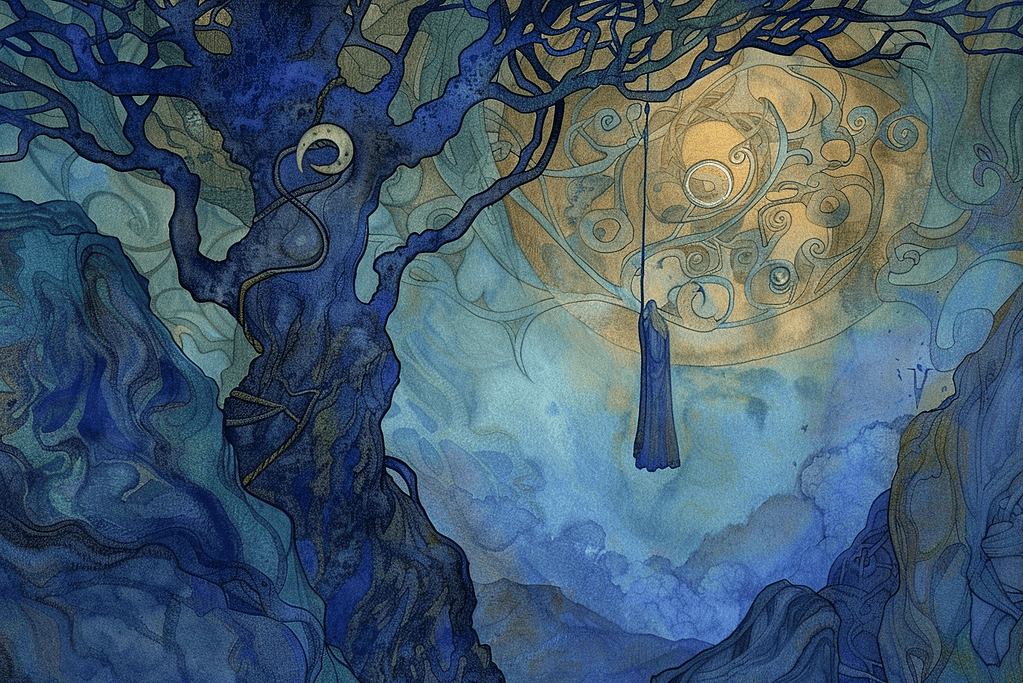
NOTE: Accurate and phD level Edda translation see here
The Prose Edda quotes (translated by Arthur Brodeur, Old Norse Literature scholar, Univ of Berkley, it’s accurate).
Odin, the Allfather, is not just a god of war and death but also a relentless seeker of wisdom. His quest for knowledge is a central theme in Norse mythology, illustrating the lengths he would go to obtain profound insights.
One of Odin’s most famous acts of sacrifice involves hanging himself from Yggdrasil, the world tree. This act was not just a display of physical endurance but a spiritual endeavor to gain esoteric knowledge.
By enduring nine days and nights without food or water, pierced by his own spear, Odin sought the mystical runes.
These runes were more than mere symbols; they held immense power and wisdom, granting him abilities such as divination and magic.
I trow I hung on that windy Tree nine whole days and nights, stabbed with a spear, offered to Odin, myself to mine own self given, high on that Tree of which none hath heard from what roots it rises to heaven.
— Hávamál (Line 137)
Odin’s thirst for wisdom did not end with the runes. He also sought out Mimir’s well, which is said to contain infinite knowledge.
To drink from this well, Odin had to make a significant sacrifice—his eye. This act highlights his willingness to endure personal loss for the greater gain of enlightenment.
“What hast thou to ask? | why comest thou hither?
Othin, I know | where thine eye is hidden.”
I know where Othin’s | eye is hidden,
Deep in the wide-famed | well of Mimir;
Mead from the pledge | of Othin each mom
Does Mimir drink: | would you know yet more? — Völuspá (Line 28)
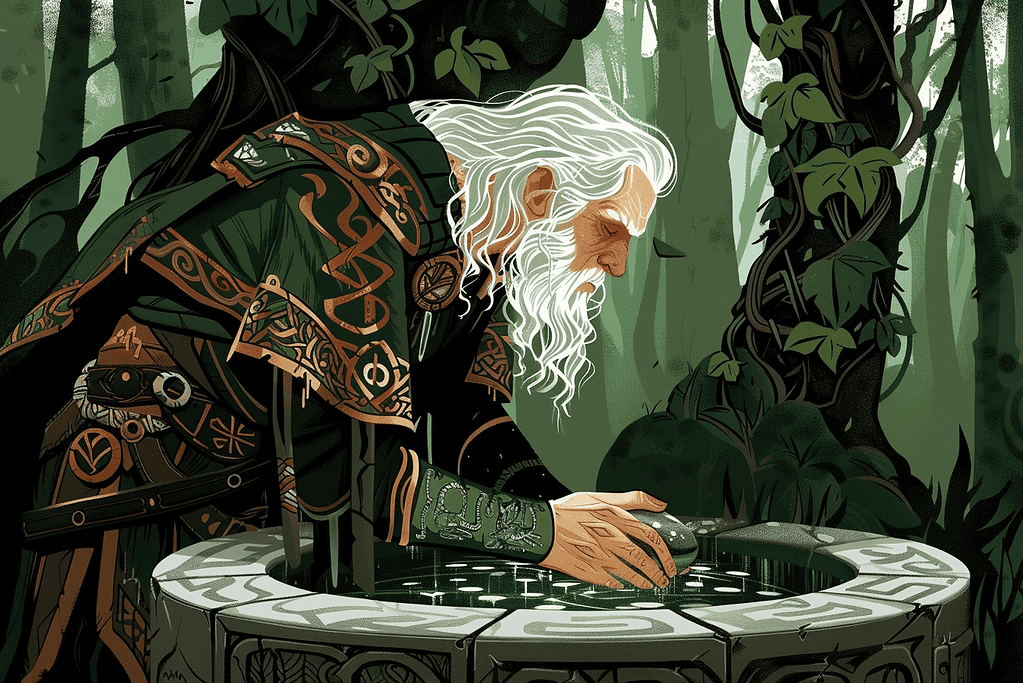
These stories illustrate that wisdom often comes at a high price. Odin’s sacrifices—whether hanging on Yggdrasil or losing an eye—underscore the belief that knowledge is not easily acquired. It requires dedication and sometimes personal suffering.
Odin’s relentless pursuit serves as an inspiring reminder that true wisdom demands effort and sacrifice.
By exploring these myths, you gain deeper insights into the values and beliefs that shaped Viking culture.
To truly understand Odin’s immense wisdom, we must look to two main written works: the Poetic Edda and the Prose Edda.
These ancient texts hold a wealth of Norse mythology, giving us insight into the thoughts and beliefs of the Viking people.
The Poetic Edda is a collection of Old Norse poems, many of which were composed in the 13th century. It is divided into different sections that contain stories about gods, heroes, and mythical beings.
Within these texts, we find a significant amount of knowledge attributed to Odin, offering deep understanding on various aspects of life.
On the other hand, the Prose Edda was written by Snorri Sturluson in the early 13th century.
It serves as a companion piece to the Poetic Edda, providing prose explanations of mythological events and characters.
This makes it an essential resource for anyone who wants to delve deeper into Norse myths and legends.

Several specific poems within these Eddas are directly associated with Odin. Each one focuses on different topics and imparts its own lessons:
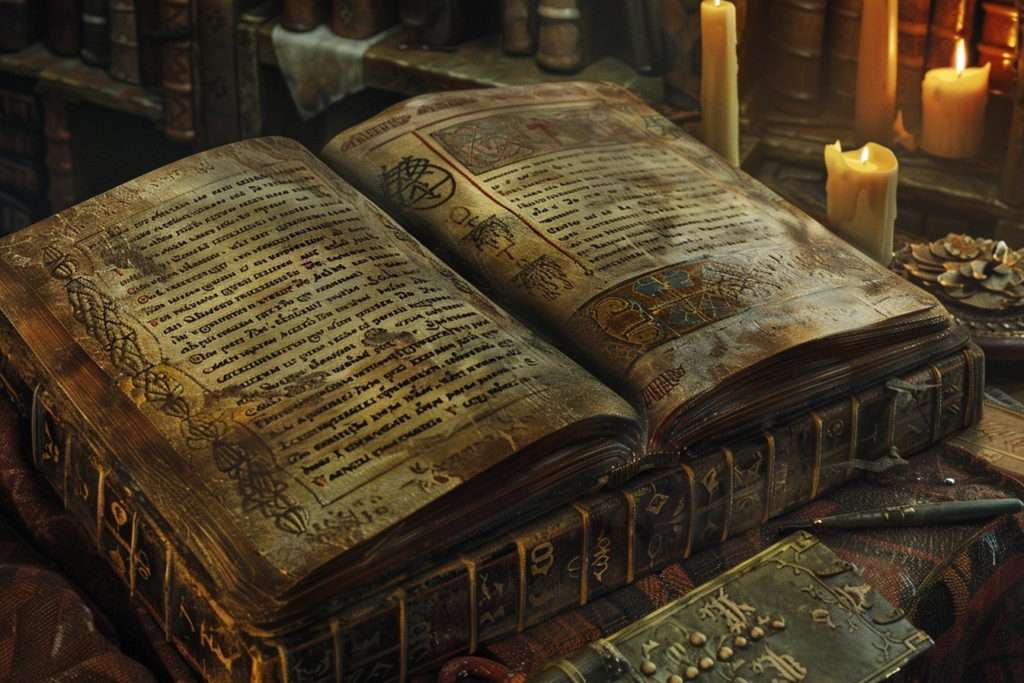
These poems not only teach us valuable lessons but also demonstrate Odin’s unending pursuit of wisdom.
They serve as timeless guides that continue to resonate with readers today.
By exploring these rich literary sources, we can begin to understand why Odin is honored as the Allfather—a deity whose wisdom encompasses every aspect of existence.
Whether we are looking for practical advice or contemplating cosmic truths, these texts offer boundless inspiration.
The Hávamál, or “Sayings of the High One,” is one of the most profound sources of wisdom attributed to Odin.
This collection of Old Norse poems provides invaluable insights into the mind and teachings of the Allfather.
These quotes reflect the core values that were cherished by Viking society and remain relevant to this day.
Context: This quote emphasizes the impermanence of life and material possessions, counterbalanced by the enduring nature of one’s reputation.
In Norse culture, where legacy and honor were paramount, this teaching underscores the importance of living a life worthy of remembrance.
Relevance Today: In our modern world, where we often get caught up in acquiring wealth and status, it’s a powerful reminder that integrity and how we treat others are what truly endure beyond our lifetime.
Context: Odin here advises caution in speech. The Vikings valued wisdom and foresight, qualities often linked to knowing when to speak and when to hold one’s tongue.
Relevance Today: This resonates strongly in an age dominated by social media where impulsive words can lead to lasting consequences.
It encourages us to think before we speak or post, valuing thoughtful communication over instant reaction.
Context: Reflecting on hospitality norms of Viking society, this quote advises guests not to overstay their welcome. The Vikings believed in balanced relationships built on mutual respect.
Relevance Today: It teaches us about respecting boundaries and understanding social cues. Overstaying one’s welcome can strain relationships, whether personal or professional.
Context: This quote from the Hávamál highlights the value of independence and self-sufficiency.
Even a modest home is better than relying on others, emphasizing personal freedom and dignity in Norse culture.
Relevance Today: In a world often focused on wealth and luxury, this reminds us of the importance of self-reliance and contentment with what we have.
It encourages pride in our own achievements and independence.
Context: This quote from the Hávamál points out the wisdom in animals that understand their limits, contrasting it with foolish people who lack self-control and moderation.
In Norse culture, moderation and knowing one’s limits were seen as important virtues.
Relevance Today: In modern times, where overindulgence is common, this quote reminds us of the value of self-discipline and moderation.
It highlights the importance of knowing when to stop and understanding our limits for a balanced life.
Context: Emphasizes the importance of diligence and early rising for achieving success. Being proactive and hardworking is essential for gaining wealth and victory.
Relevance Today: In our fast-paced world, it reminds us that success comes to those who are diligent and proactive.
It highlights the importance of hard work and taking initiative in achieving our goals.
Context: Highlights the essential elements of a good life: warmth, sunlight, health, and honor. These basic needs and virtues were highly valued in Norse culture.
Relevance Today: Reminds us to appreciate simple but vital aspects of life, such as good health and living honorably.
In a world often focused on material wealth, it underscores the importance of well-being and integrity.
The Hávamál offers timeless wisdom through its verses, guiding us toward a life marked by honor, prudence, independence, preparedness, ambition, and simplicity.
Each quote encapsulates principles that are relevant across cultures and generations.
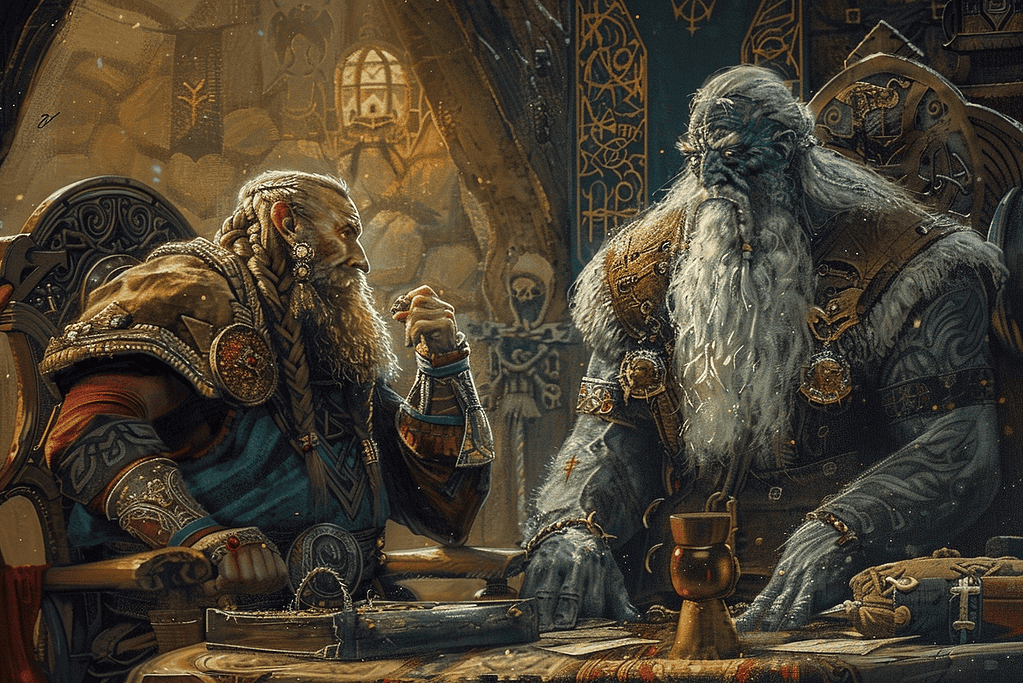
The Völuspá is a revered poem within the Poetic Edda, offering rich narratives that encompass the creation and eventual destruction of the world.
Through its lines, Odin’s wisdom and foresight shine brilliantly. Here are some compelling quotes attributed to Odin from this ancient text:
Context: Reflects on Odin’s memories of ancient giants and their generosity. It also alludes to the nine worlds connected by Yggdrasil, the World Tree, highlighting a deep connection to Norse cosmology and myth.
Relevance Today: Encourages us to remember and honor our roots and the wisdom of the past. In a modern context, it reminds us of the importance of cultural heritage and the interconnectedness of all things.
Context: seek knowledge from all beings, invoking Odin’s guidance to accurately recount ancient stories.
This underscores the reverence for oral traditions and the importance of preserving history through storytelling.
Relevance Today: Highlights the value of seeking knowledge and wisdom from diverse sources. It reminds us of the importance of preserving and sharing our cultural narratives and learning from the past.
Context: Referring to Yggdrasil, the immense World Tree that connects all realms of existence in Norse cosmology.
Odin’s intimate knowledge of Yggdrasil underscores his profound understanding of life’s interconnectedness.
Relevance Today: Recognizing interconnectedness in our lives fosters a holistic perspective on personal and community well-being.
It reminds us that actions in one area can impact others significantly.
Context: Odin recounts how the gods gathered to discuss whether to give tribute to specific deities or to share worship equally among all.
This reflects the importance of decision-making and unity among the gods.
Relevance Today: Highlights the significance of decision-making and equality. It encourages us to consider fairness and collective benefit in our own communities and organizations.
Context: Odin speaks of his vast vision and knowledge across all worlds, emphasizing his role as a seeker of wisdom and guardian of the cosmos.
Relevance Today: Encourages a broad perspective and the pursuit of knowledge. It reminds us to look beyond our immediate surroundings to understand the larger picture and gain a deeper insight into our world.
Context: This vivid description foretells Ragnarök’s cataclysmic events when natural order collapses, signifying an end but also a new beginning.
Relevance Today: Embracing change as an inevitable part of life encourages resilience during transitions or crises. It offers hope that endings pave the way for new beginnings.
Context: Odin envisions the renewal of the earth after Ragnarök, with the land emerging green and vibrant from the sea.
Waterfalls flow, eagles soar, and life begins anew, symbolizing rebirth and hope.
Relevance Today: Emphasizes the themes of renewal and resilience. It reminds us that after periods of destruction or hardship, there is always the potential for new beginnings and the regeneration of life.
Context: Odin describes how the gods gathered at Ithavoll to rebuild after Ragnarök. They constructed shrines, temples, and forges, crafting tools and creating a new world from the remnants of the old.
Relevance Today: Highlights the importance of rebuilding and creation after destruction.
It encourages us to come together, use our skills, and work collaboratively to restore and improve our world after challenging times.
These quotes from Völuspá capture Odin’s profound insights into existence’s cyclical nature, interconnectivity, foresight, resilience amidst adversity, and an unquenchable thirst for knowledge
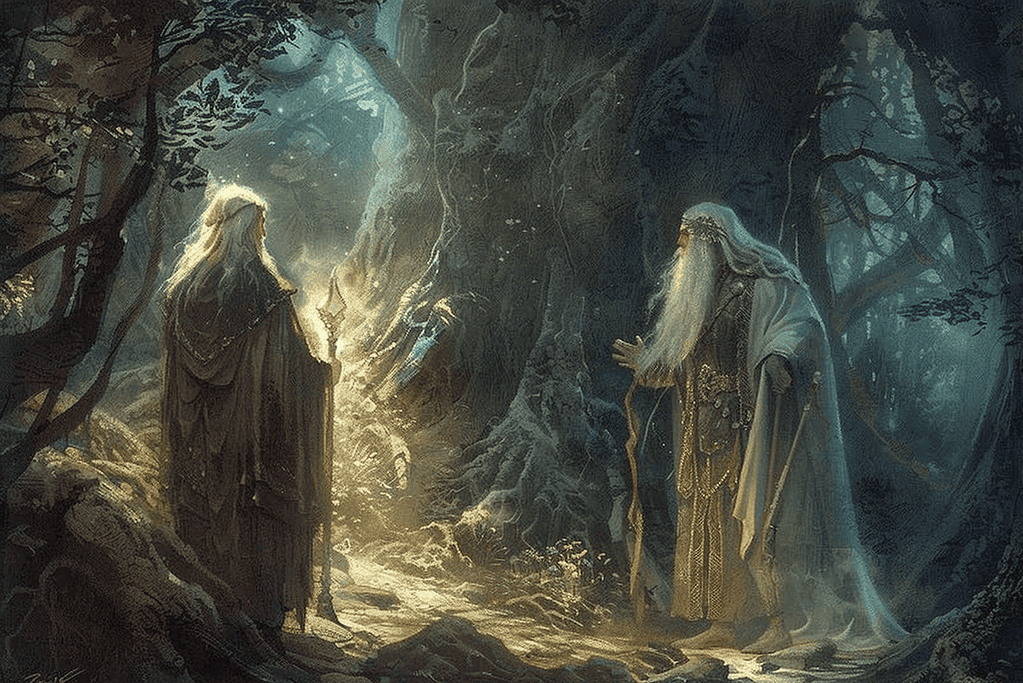
The “Vafthruthnirsmal” is a poem from the Poetic Edda where Odin engages in a wisdom contest with the giant Vafthrudnir.
This gripping tale showcases Odin’s unparalleled quest for knowledge and his mastery in riddles and lore.
Here are some profound quotes from this saga, each offering a glimpse into the Allfather’s wisdom:
Context: Odin seeks advice from Frigg before embarking on a journey to challenge the giant Vafthruthnir in a contest of wisdom.
This illustrates Odin’s unending quest for knowledge and the value he places on wise counsel.
Relevance Today: Emphasizes the importance of seeking advice and knowledge from others. It encourages us to value wisdom and collaboration when facing challenges or seeking personal growth.
Context: Frigg expresses her concern about Odin’s intention to challenge Vafthruthnir, recognizing the giant’s unmatched wisdom and strength among his kind.
This reflects the importance of caution and awareness of potential risks.
Relevance Today: Highlights the need to carefully consider risks and seek wise counsel before taking on significant challenges.
It reminds us to be aware of our limitations and to prepare thoroughly when facing formidable opponents or situations.
Context: Frigg wishes Odin safety and sharpness of mind for his journey and encounter with the giant Vafthruthnir.
This emphasizes the importance of preparation, wisdom, and protection during perilous endeavors.
Relevance Today: Encourages us to seek safety and clarity of mind in our ventures. It underscores the value of support and well-wishes from loved ones when embarking on challenging tasks or journeys.
Context: Frigg wishes Odin safety and keen intellect for his journey to meet the giant Vafthruthnir.
This emphasizes the importance of wisdom and protection when facing significant challenges.
Relevance Today: Reminds us to prioritize safety and mental sharpness in our pursuits.
It highlights the value of support from loved ones and careful preparation when taking on difficult tasks.
Context: Odin, under the alias Gagnrath, arrives at the hall of the giant Vafthruthnir, seeking hospitality and a warm welcome after a challenging journey.
This shows Odin’s strategic approach and the customs of hospitality in Norse culture.
Relevance Today: Highlights the importance of kindness and hospitality towards strangers.
It encourages us to be welcoming and considerate to those who have traveled far or faced difficulties, fostering a sense of community and support.
Context: This passage advises a poor person on how to behave when in the presence of the wealthy.
It highlights the social and economic disparities, suggesting that the poor man should carefully consider his words or choose silence to avoid negative consequences, especially when dealing with someone unkind or unsympathetic.
Relevance Today: Encourages mindful communication in situations with significant power dynamics.
It reminds us to be cautious and measured in our speech, understanding the potential risks of speaking too freely, particularly when interacting with those who may lack empathy or hold more power.
Context: Odin describes Skinfaxi, the horse that brings daylight to humanity. Known for his radiant mane and esteemed by heroes, Skinfaxi symbolizes the arrival of a new day and the light it brings.
Relevance Today: Highlights the timeless appreciation for the start of a new day and the hope it brings.
It reminds us to value the opportunities each new day offers and to recognize the beauty and potential in beginnings.
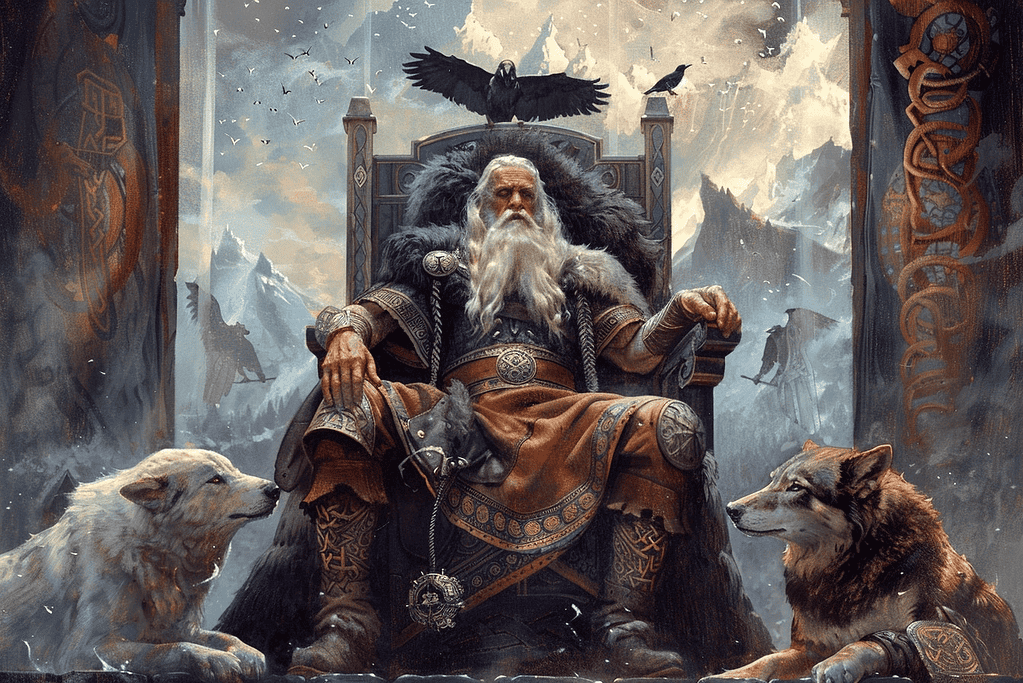
The Grimnismal, or “The Lay of Grimnir,” is a crucial poem within the Poetic Edda. It features Odin, disguised as Grimnir, imparting knowledge to the young prince Agnar.
The poem is a treasure trove of wisdom, cosmological insights, and divine perspectives. Here are some handpicked quotes that showcase Odin’s profound understanding and foresight.
Context: This passage from the Grímnismál in the Poetic Edda refers to two significant locations in Norse mythology: Ýdalir and Alfheim. Ýdalir, or “Yew Dales,” is the home of Ullr, the god associated with archery, skiing, and hunting.
Alfheim is the realm of the light elves, given to Freyr as a “tooth-gift,” a traditional gift marking a child’s first tooth.
Relevance Today: Highlights the importance of cultural heritage and the significance of places tied to traditions and deities.
Reminds us to honor our historical roots and recognize the symbolic meanings behind gifts and locations in our cultural narratives.
Context: The passage refers to Thrymheim, the home of the giant Thjazi. Thrymheim, meaning “Thunder-home,” is an icy stronghold in the highest peaks of Jotunheim.
This realm is known for its perpetual snow and harsh conditions.
Relevance Today: Highlights the fascination with mythological places and figures of great power.
Reminds us of the rich stories and characters in cultural heritage, encouraging an appreciation for mythology and its impact on storytelling and tradition.
Context: The passage refers to Himinbjorg, the home of Heimdall. Himinbjorg, meaning “Heaven’s Castle” or “Heaven-Mountain,” is strategically located where the rainbow bridge Bifröst meets the sky.
Heimdall, known as the guardian of Bifröst, possesses extraordinary senses and is tasked with protecting Asgard from threats.
In his well-built house, Heimdall enjoys good mead, reflecting a common motif in Norse mythology where gods partake in divine sustenance.
Relevance Today: Highlights the importance of vigilance and protection.
It reminds us to appreciate the roles of guardians and protectors in our lives, as well as the value of enjoying simple pleasures amidst responsibilities.
Encourages an appreciation for mythology and its impact on storytelling and cultural heritage.
Context: The passage describes Noatun, the home of the god Njord. Noatun, meaning “Ship-enclosure,” is a grand, high-timbered hall by the sea.
This reflects Njord’s strong association with the sea, ships, and seafaring. Njord is a prominent deity among the Vanir, known for his connections to the sea, wind, and wealth, and is the father of Freyr and Freyja.
Relevance Today: Highlights the importance of maritime culture and the protection and blessings sought from deities associated with the sea.
Encourages appreciation for the significance of leadership that brings peace and prosperity.
Reminds us of the cultural and historical importance of deities who oversee vital aspects of life, such as seafaring and trade.
Context: The passage describes Odin’s ravens, Hugin and Munin, who fly over Midgard (Mithgarth) each day.
Hugin represents thought, and Munin represents memory. Odin expresses his concern for their return, particularly for Munin.
Relevance Today: Highlights the importance of thought and memory in our lives. Encourages us to value and protect our ability to think critically and remember our experiences.
Reminds us of the constant need to balance and safeguard both intellectual pursuits and personal memories.
Context: The passage describes Valhalla, Odin’s hall in Asgard, which has 540 doors.
Each door can accommodate 800 warriors who will march out to battle the wolf Fenrir during Ragnarök.
This showcases the immense size and capacity of Valhalla, emphasizing the readiness and valor of the Einherjar, the chosen slain warriors, for the final battle.
Relevance Today: Highlights themes of readiness and unity in the face of significant challenges.
Encourages us to be prepared and work together when facing large-scale adversities.
Reminds us of the importance of collective strength and solidarity in overcoming obstacles.
Context: The passage refers to a significant event in Norse mythology, likely connected to the cataclysmic events of Ragnarök.
It describes the gods gathering at Yggdrasil, the sacred ash tree, to face their fates. Bifröst, the bridge connecting Asgard to Midgard, burns in flames, and the sacred waters seethe, symbolizing the chaos and destruction during Ragnarök.
Relevance Today: Reminds us of the themes of judgment and the inevitable cycles of destruction and renewal.
Encourages reflection on the importance of justice and the transformative power of cataclysmic events.
Highlights the need to prepare for and navigate through times of great change and upheaval.
These quotes from Grimnismal reveal layers of wisdom that transcend time, offering timeless advice on life, relationships, and personal conduct.
Each one provides not just insight into Norse mythology but also practical guidance applicable in today’s world.
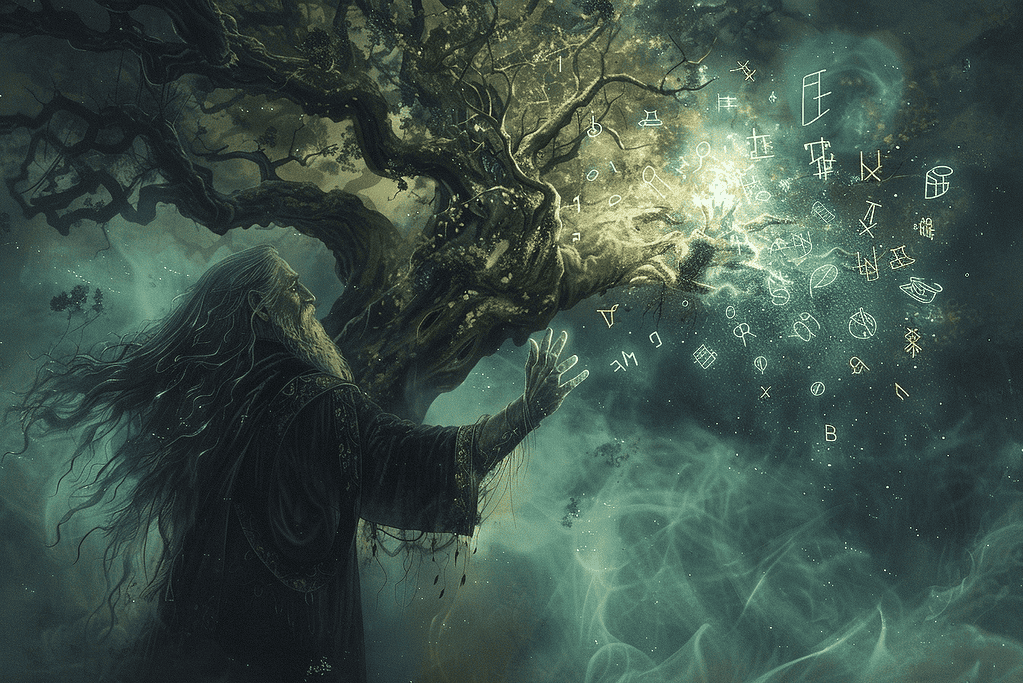
The Prose Edda, written by Icelandic scholar Snorri Sturluson in the 13th century, serves as a cornerstone for our understanding of Norse mythology.
This invaluable source provides vivid narratives that bring the gods, including Odin, to life.
Let’s delve into some of Odin’s most profound quotes from this rich literary treasure and explore their meanings.
Context: The passage refers to a mythological event involving the goddess Gefjun and King Gylfi.
Gefjun, an ancient Norse goddess associated with agriculture, fertility, and prosperity, tricks King Gylfi of Sweden into granting her land.
She transforms her four sons into oxen to plow a large tract of land, which is then moved to the sea, creating the Danish island of Zealand.
The passage emphasizes the supernatural strength of the oxen and Gefjun’s cunning.
Relevance Today: Highlights themes of resourcefulness and transformation.
Encourages appreciation for mythological stories that explain natural phenomena and cultural history.
Reminds us of the power of ingenuity and the importance of understanding and preserving cultural narratives.
Context: The passage uses vivid imagery to describe aspects of Valhalla, Odin’s hall, and the warriors who reside there.
It refers to the shields of the warriors, described as “sore battered with stones,” serving as shingles for Valhalla’s roof.
These shields symbolize the valor and resilience of the warriors.
Relevance Today: Highlights themes of resilience and strength. Encourages appreciation for the toughness and resourcefulness of those who endure harsh conditions.
Reminds us of the importance of perseverance and the ability to withstand challenges, drawing parallels to the enduring nature of mythological heroes and their symbols.
Context: The passage describes Thor’s daily journey to Yggdrasil, the world tree, and the challenges he faces.
Thor must wade through the rivers Körmt, Örmt, and the Kerlaugs to reach Yggdrasil because Bifröst, the burning rainbow bridge, is aflame and impassable.
The imagery of the holy waters howling emphasizes the difficulty of his journey.
Relevance Today: Highlights themes of perseverance and duty.
Encourages us to recognize the effort required to fulfill our responsibilities, even when facing significant obstacles.
Reminds us of the importance of determination and resilience in overcoming daily challenges.
Context: The passage describes Yggdrasil, the central and sacred tree in Norse cosmology, and its connection to Urdr’s Well.
Yggdrasil is depicted as a towering ash tree, often referred to as the “World Tree” because it connects all nine realms of existence.
Its branches and roots symbolize the interconnectedness of all life and the universe.
Relevance Today: Highlights the themes of interconnectedness and continuity. Encourages appreciation for the natural world and its cycles.
Reminds us of the importance of deep roots and resilience, symbolized by the evergreen nature of Yggdrasil, which stands strong through all conditions.
The tree’s nourishment by the Norns with water and clay from Urdr’s Well signifies the maintenance of cosmic order and the flow of time and fate.
Context: The passage refers to Bilskirnir, the hall of the god Thor, highlighting its immense size and significance.
Bilskirnir, Thor’s grand hall, is described as having “five hundred floors and more than forty,” showcasing its vastness and reflecting Thor’s prominence among the gods.
Relevance Today: Highlights themes of grandeur and pride in one’s achievements. Encourages appreciation for remarkable feats and constructions that symbolize strength and stature.
Reminds us of the importance of recognizing and valuing significant accomplishments and the legacy they create.
The mention of Bilskirnir’s “bending ways” suggests its intricate and complex design, further emphasizing the hall’s grandeur and Thor’s formidable presence.
Context: The passage refers to the unique and mythologically significant birth of Heimdall, a prominent god in Norse mythology.
Heimdall is described as being born of nine mothers, who are also nine sisters.
These sisters are often identified as the Nine Daughters of Ægir and Rán, who personify the waves of the sea.
This connection emphasizes Heimdall’s divine and elemental origins, highlighting his extraordinary nature and importance within the pantheon.
Relevance Today: Highlights themes of uniqueness and exceptional origins. Encourages appreciation for individual uniqueness and the extraordinary aspects of our own origins or backgrounds.
Reminds us of the value of diversity and the special qualities that different backgrounds and stories bring to our lives.
The reference to Heimdall’s birth from nine sisters also underscores the interconnectedness of nature and the divine, symbolizing the harmonious relationship between different elements of existence.
Context: The passage is spoken by Gerd (Gerðr) in the Prose Edda. Gerd, a beautiful giantess, becomes the object of Freyr’s intense love.
Freyr sends his servant Skirnir to woo her. After much persuasion, Gerd agrees to meet Freyr in nine nights.
The lines capture her anticipation and impatience during the wait, highlighting the emotional weight and the slow perception of time.
Relevance Today: Highlights themes of anticipation and the subjective experience of time. Encourages empathy for those enduring periods of longing and anxiety.
Reminds us that emotional states can greatly influence our perception of time, making short periods feel interminably long.
These quotes from the Prose Edda provide timeless insights that resonate across centuries.
They offer guidance on how we might navigate our own lives with greater awareness and integrity, much like Odin himself.
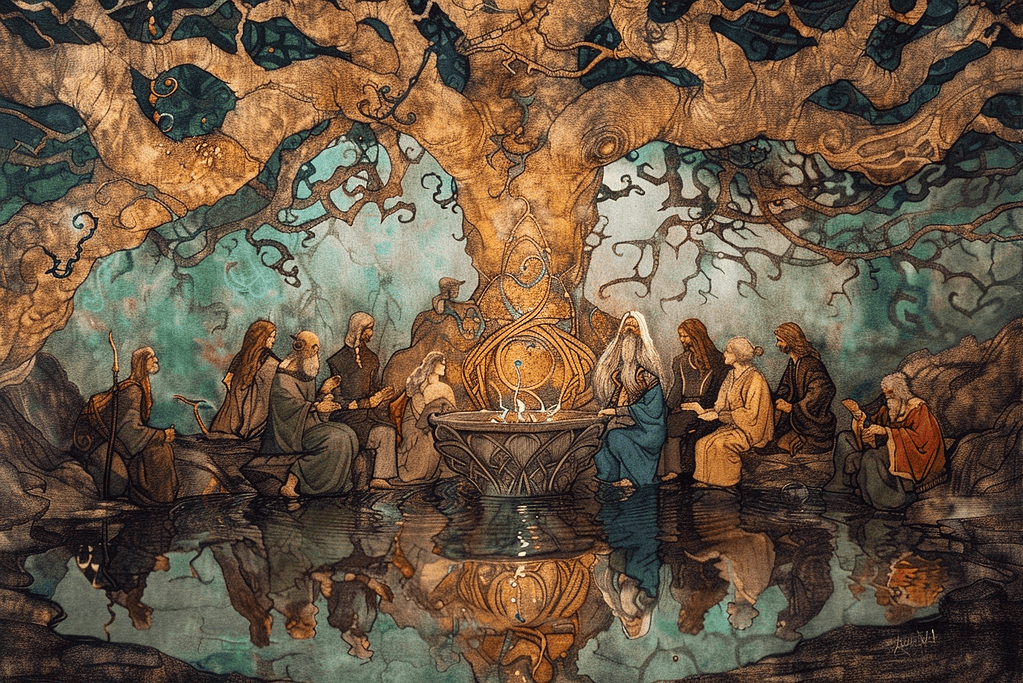
Odin’s relentless pursuit of knowledge and wisdom is a central theme in Norse mythology, and his teachings continue to resonate through the ages.
The rich tapestry of quotes from the Hávamál, Völuspá, Vafthruthnirsmal, Grimnismal, and Prose Edda reveal the depth of his insights on life, ethics, and the cosmos.
These texts not only offer a glimpse into the values and beliefs of the Viking era but also provide timeless guidance that remains relevant today.
By studying these ancient works, we can appreciate the profound impact of Odin’s wisdom and its enduring legacy in our modern world.